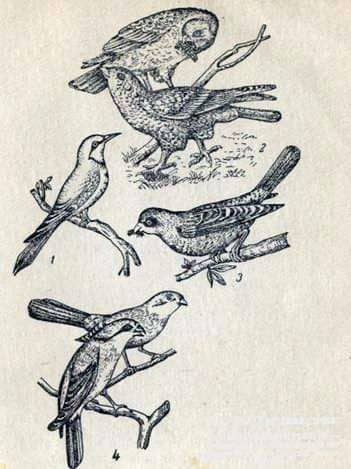
Golden mulberry, or icteric, goldfish (Merops apiaster P.), is a small insectivorous bird flying in flocks.
Arriving in packs on apiaries or in the places of flight of bees, the beetles destroy large numbers of bees-pickers, tearing or greatly reducing honey collectors. Beefs also destroy a mass of bumblebees, which cause great harm to the seed clover.
A golden beak of bright contrasting feathers, a little more than a starling, weighing about 50 g. It has a black, long, thin, slightly curved down beak 3.5 cm long; Its head is near the beak, white, the crown is bluish-green. From the ear through the eyes to the beak is a black streak. The iris of the eyes is red. The throat is golden yellow, separated from the chest by a black strip. Nadhvoste yellow-brown, lower back ocher-yellow. The wings are blue, green and brown; tail is greenish-blue, wedge-shaped, with ten steering feathers, two of them are elongated. The middle finger is fused with the adjacent to the second joint, and with the lateral to the first joint. Legs are reddish-brown. The female differs from the male in a greenish tinge on the back. Young forks have a yellowish forehead, there is no black band on the chest.

Fig. 35. Predator bees:
1 – golden bee-eater; 2 – bee-eater; 3 – black-throated shrike; 4 – red shrike.
By flight, the beetles resemble swallows and swifts, fly in packs. They often sit on trees, bushes, telegraph poles and wire, fences. They fly with a shrill cry, heard over long distances. Nests are served in the ground on cliffs and steep slopes, often along the banks of rivers or in gullies and ravines. In a steep wall, they make holes 5-6 cm in diameter, about 1 m below the top layer of the soil. The chicks fly out of the nest in July. Hibernation in South Africa is hibernated, from where they arrive in late April or early May. Departing, they cover the holes of their nests with clay of centimeters by 10, which eliminates their settling by other birds.
Bunnies hunt for insects on quiet, sunny days at high altitude, in windy and cloudy – on less, on rainy and cloudy days – low, almost at the surface of the earth. On rainy days, the beetles fly to the apiaries, sit on the incoming hive boards and grab the bees from the tapes. In rainy time, they also descend to the ground to burrows of bumblebees and destroy them.
One beef, if fed only by bees, destroys them in a day about 700-1000 pieces. In the areas where the apiaries are located 80-90% of bee eaten by insects are bees. If we assume that there are 30,000 flying bees in the family, then one beetle destroys about 2-3% per day. In one beetle, up to 180 corpses of bees were found in goiter, and in their language a mass of bee stings. However, the bee venom does not act on them. One pair of shtukok for 2-3 summer months destroys up to 2 thousand bees, and a flock of 100 birds makes an apiary into 50 families of unprofitable. Buns are harmful not only near the apiary, but also in the distance, where they catch bees during the summer on honey plants.
Beefs do the most damage in July and August, until mid-September. By this time, the number of them due to the withdrawal of young offspring is greatly increasing. In July and August, in places where there is a strong spread of spike-grasses, sometimes almost all flying bees are destroyed, as a result of which the family’s activity is greatly weakened even if there is a good nectar in nature. During this period, beef can kill most young queens during a mating departure.
The use of foxes in destroying insects harmful to agriculture and forestry is insignificant. At the same time, they bring great harm to beekeeping.
Prevention. The protection of bees from golden bees is based on mass destruction by all means of its nests. It is recommended to destroy birds and chicks in nests with carbon disulphide or chloropicrin. Destruction of spiders is carried out in the spring, shortly after they return from wintering. To do this, in the evening, when each beef will be in the nest, balls from the pakli, impregnated with carbon disulphide (or chloropicrin), are thrown into the holes, and they are clogged with earth. Bugs under the influence of gases die. It is useful to carry out such measures by district, regional or republican organizations on a large scale with the involvement of the population.
Control measures. One of the most accessible measures for protecting the apiary from sturgeon is shooting from a gun.
Как выделать шкуру лося. Борьба с паразитами у животных.
Predator bees